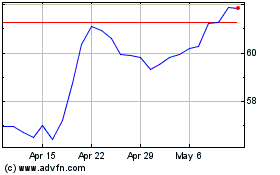Wells Fargo Names Charles Scharf President, CEO--2nd Update
September 27 2019 - 9:12AM
Dow Jones News
By Allison Prang and Colin Kellaher
Wells Fargo & Co. named Bank of New York Mellon Corp. Chief
Executive Charles Scharf as its new CEO, ending a six-month search
for a leader capable of restoring the bank's battered reputation
and improving its standing with regulators.
Wells Fargo said Mr. Scharf will join the bank as president and
CEO on Oct. 21. He succeeds C. Allen Parker, Wells Fargo's general
counsel, who has been serving as interim chief since Timothy Sloan
resigned in late March.
Mr. Scharf spent four years as the CEO of Visa before taking the
BNY Mellon job in July 2017. Prior to joining Visa, he was a top
lieutenant to JPMorgan Chase & Co. CEO James Dimon and spent
seven years running the bank's sprawling consumer operation.
Mr. Scharf has a tough job ahead of him at Wells Fargo, which
has been struggling to right itself since a fake-account scandal
erupted at the bank three years ago. Atop the agenda is getting
back in the good graces of regulators, who have been unsatisfied
with its response to problems exposed by the sales scandal. The
bank's operations also have suffered.
Mr. Scharf has experience with turnarounds. He was tasked with
overhauling BNY Mellon, a bank that handles much of Wall Street's
vital back-end work, such as tracking the value of securities. He
has slashed expenses but has been reluctant to set concrete targets
for the revamp. Revenue growth has been muted, and the stock has
fallen 9% in the past year.
Wells Fargo embarked on its own overhaul following the sales
scandal, reorganizing divisions and appointing new executives. Yet
problems continued to emerge throughout the bank over the past
three years. Nearly every one of its business lines is under
investigation by a government agency, including the Justice
Department and the Securities and Exchange Commission.
Until the 2016 scandal, Wells Fargo enjoyed a sterling
reputation as a bank that dodged the worst abuses of the financial
crisis. Mr. Sloan, a Wells Fargo veteran, took over as CEO at the
height of the scandal, following John Stumpf's resignation. By that
point, the bank's folksy image was in tatters.
Restoring it has proved difficult, especially where regulators
are concerned. In February 2018, the Federal Reserve took the
unprecedented step of capping the bank's growth, citing
risk-management deficiencies.
A few months later, the Consumer Financial Protection Bureau and
the Office of the Comptroller of the Currency imposed a $1 billion
fine on the bank for misconduct in its auto- and mortgage-lending
business. The OCC said it found risk-management deficiencies that
"constituted reckless, unsafe or unsound practices," leading to
improper charges to hundreds of thousands of consumers.
Regulators stepped up their pressure on the bank earlier this
year, leading to Mr. Sloan's resignation.
"I could not keep myself in a position where I was becoming a
distraction." Mr. Sloan said in a call with investors announcing
his resignation.
Dave Sebastian contributed to this article.
Write to Allison Prang at allison.prang@wsj.com and Colin
Kellaher at colin.kellaher@wsj.com
(END) Dow Jones Newswires
September 27, 2019 08:57 ET (12:57 GMT)
Copyright (c) 2019 Dow Jones & Company, Inc.
Wells Fargo (NYSE:WFC)
Historical Stock Chart
From Mar 2024 to Apr 2024

Wells Fargo (NYSE:WFC)
Historical Stock Chart
From Apr 2023 to Apr 2024
